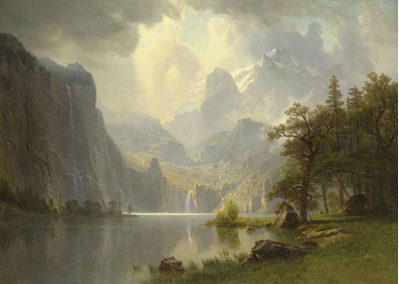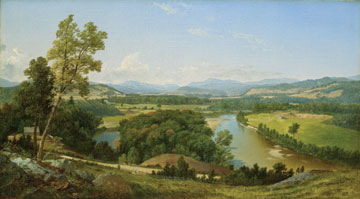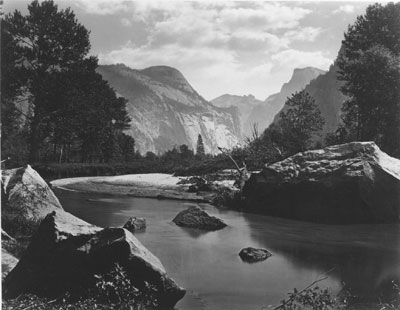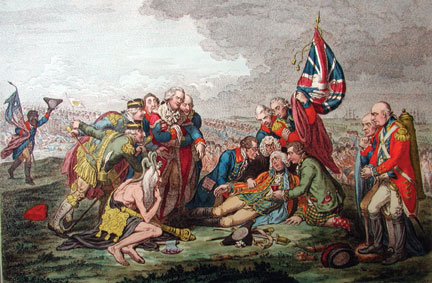
Albert Bierstadt, American, 1830-1902,In
the Mountains, 1867, oil on canvas,
The Wadsworth Atheneum
Museum of Art
By
Ellen S. Wilson By
the 19th century, industry was changing forever
the way people lived. Many of the forests in the Old
World had been cut and burned, machinery ran on coal,
and most people in England lived in urban areas rather
than on farms. The New World was not to be left behind—there,
too, cities were expanding, forests were leveled, and
human domination of the natural world was America’s
Manifest Destiny, a goal ordained by God. Ironically,
during this time an appreciation for the beauties of
nature, captured by landscape painters and photographers,
took hold of the public imagination. Americans bragged
about the grandeur of their trees, even as they cut
them down.
Opening February 21, two exhibitions at Carnegie
Museum of Art illustrate the mindset of artists and
thinkers
in the New World. Hudson River School: Masterworks
from the Wadsworth Atheneum Museum of Art contains
55 masterpieces from the best collection of Hudson
River School paintings in the world. Eloquent
Vistas: the Art of 19th-Century American Landscape
Photography
from the George Eastman House Collection, Rochester,
New York, is a survey of the American landscape photograph.
Together, these exhibitions seize a moment when America
was all potential, when frontiers were still waiting
to be explored, and leaving a mark on the wilderness
was a noble pursuit.
Hudson River School:
Masterworks
from the Wadsworth Atheneum Museum of Art

Thomas Cole, American,
1801-1848, Scene from "The Last of
the Mohicans," Cora Kneeling at the Feet
of Tamenund, 1827, oil on canvas, The
Wadsworth Atheneum Museum of Art
The Power of Landscape Paintings
America’s first school of landscape
painters arose from a natural awe of and
respect for the wonders
of the new continent. “This was the first self-conscious attempt
to make American landscape paintings,” says
Louise Lippincott, curator of fine art at Carnegie
Museum of Art. “There
was a deep interest in specifically American scenes—they
really became images of patriotic optimism.”
The
unexplored vistas were so much bigger and freer
than the comparatively tame and manicured English
countryside. The Hudson River school painters explored
the Connecticut
River, Niagara Falls, and Lake George in upstate
New York—the territory memorialized by novelist
James Fenimore Cooper in his Leatherstocking
Tales.
The land
at its moment of transformation from wild to tame
was a dynamic subject. Early in the century, the
natural
world was a powerful force; by the end, nature
had been largely subjugated to human will.
The arrival
of painter Thomas Cole in New York
City in 1825 marks the beginning of the Hudson
River school,
which lasted until about 1870. The core of
the collection at the Wadsworth Atheneum Museum
of
Art was formed
by two patrons, Daniel Wadsworth (1771-1848),
who founded the museum, and Elizabeth Hart
Jarvis Colt
(1826-1905),
widow of arms manufacturer Samuel Colt. Both
patrons commissioned many of the works in
the collection.
“
This is a masterpiece show,” says Lippincott. “These
are great pictures, probably the best collection
of this school of painting in the country.
People should
come in and be prepared to revel in the splendor
of it.”
And splendid these works are,
both in technique and subject matter. Niagara
Falls, painted
by Cole’s
apprentice Frederic Edwin Church in 1856, is
emblematic of the school as it captures the
awe-inspiring power
of the water, the ever-present rainbow, a small
watchtower, and three tiny houses—reminders
that man is insignificant in the face of natural
forces. The Falls themselves
were already a national icon, a reminder that
this young country had more powerful waterfalls,
bigger
trees, and untamed wilderness than the continent
most of its inhabitants had left behind. With
the opening
of the Erie Canal in 1825, Niagara Falls was
a popular tourist destination, and nearly every
landscape painter
of this period painted it. This exhibition
alone includes paintings of the Falls by John
Trumbull, John F. Kensett,
Alvan Fisher, and Thomas Chambers, in addition
to Church.
Masters of the Earth
Thomas Cole, reflecting on the opportunities for painters
in this country, remarked “All nature here
is new to Art,” adding the scenes of Europe
were “hackneyed and worn by the daily pencils
of hundreds,” but for the American painter,
the forests, lakes, and falls “had been preserved
untouched from the time of creation for his heaven-favored
pencil.”

David Johnson,American,
1827-1908
Study, Franconia Mountains from West
Campton, New Hampshire, c.1861-63,
oil on canvas,The
Wadsworth Atheneum Museum of Art
Cole found special inspiration in Cooper’s
tales of the steadfast scout Natty Bumppo, or Hawkeye.
One
of his more famous works illustrates a climactic scene
from The Last of the Mohicans, in which a young woman,
one of several English people kidnapped by an American
Indian, pleads for mercy from the wise old chief Tamenund.
In the novel, the scene is all cunning talk, manipulation,
and ritual diplomacy, as the evil Indian Magua bargains
for his prisoners. In Cole’s interpretation,
these human events are nothing in the face of the
majesty of the mountains. While Cooper set the
scene in the
area around Lake George, Cole drew on the White
Mountains of New Hampshire as a more fitting backdrop. “The Hudson River painters freely rearranged
the topography to improve the landscape,” explains
Lippincott. “The
goal was to create a strong emotional reaction
in the viewer.”
The novel ends as Chingachgook,
the grieving father of the recently murdered
last Mohican, states, “The
pale-faces are masters of the earth and the time
of the redmen has not yet come again.” Cole,
in his painting, complicates this statement,
for who can
ever master this awe-inspiring place? The round
boulder perched on the pinnacle in the background
serves to
remind the viewer of how small the human inhabitants
are and how temporary their stay.
Hudson River School: Masterworks from the
Wadsworth Atheneum Museum of Art has been organized
by the Wadsworth Atheneum Museum of Art, Hartford,
Connecticut. The national tour is sponsored
by MetLife Foundation.
Generous
support for the exhibition’s
presentation in Pittsburgh has been provided
by The Laurel Foundation. Additional support
has been provided by The Fellows and Associates
Funds of Carnegie Museum of Art.
Eloquent Vistas:
Documenting
the Disappearing Wilderness

Eadweard Muybridge,
American, 1830-1904, The Domes from Merced
River,
Yosemite Valley, c.
1874, albumen print, George Eastman House
Just as the Hudson River painters manipulated
the scenery they painted, photographers also
created a scene by the act of choosing and
framing it. And here too, the irresistible
appeal of Niagara Falls, as well as other natural
sights, were popular subjects. As many of the
photographs were taken later in the century,
they also document great changes in the continent,
the building of the railroads, and the battlefields
of the Civil War, as the country struggled
to establish its identity.
Early landscape photographers
had to face physical challenges and manage
cumbersome technology
that painters did not. Until the 1880s, photographers
had to prepare the negative just before exposure,
and then immediately develop and fix it while
the chemicals on the plate were still damp,
necessitating the presence of some sort of
traveling darkroom. And because enlarging
was expensive, most photographers made contact
prints by placing the negative directly on
the contact paper, making the finished print
the same size as the negative. The photographs
in Eloquent Vistas are all contact prints
made
in this way, and as the scenery of the period
seemed to require large photographs, the
cameras used to take the pictures had to be
even larger.
 Eadweard Muybridge,
American, 1830-1904, Vernal Fall, 350
Ft., Yosemite Valley, c. 1874, albumen
print, George Eastman House Eadweard Muybridge,
American, 1830-1904, Vernal Fall, 350
Ft., Yosemite Valley, c. 1874, albumen
print, George Eastman House
But the very act of photographing
the wilderness, especially the western wilderness,
changed
both the public perception and the use
of it. The development of trains and telegraphs
brought
tourists, lured by the pictures made along
the route of the railroad tracks. It was
photographs of Yellowstone that led President
Ulysses Grant
to sign a bill in 1872 protecting its natural
state, and photographs also led to the
conservation
of Yosemite. By the end of the century,
an industrial aesthetic replaced the natural
one. The
frontier was
more accessible and less mysterious.
American artists concentrated on urban subjects,
studied the human figure, and turned
away
from broad
views of the disappearing wilderness.
Eloquent
Vistas: The Art of 19th-Century American
Landscape Photographers from the George Eastman
House Collection has been organized by the
George Eastman House International Museum of
Photography and Film. Generous support has
been provided by The William Talbott Hillman
Foundation, Inc. and the W.P. Snyder III Charitable
Fund.
A concurrent exhibition from the Yale Center
for British Art also looks back to works inspired
by a search for national identity.
The Romantic Print in Britain 
James Gillray (1757-1815), The
Death of the Great Wolf, 1795, etching and engraving with hand-coloring,
Yale Center for British Art.
The Romantic Print in Britain (1776-1880)
covers a period that includes the American War
of Independence,
the French Revolution, the Napoleonic wars,
and the growth of the British Empire, which led
to
an increased slave trade as well as to colonies
in America, India, the South Seas, and the
Caribbean. The prints in this exhibition illustrate
these
conditions, as well as the Romantic obsession
with celebrities and historic events.
Unlike
the Hudson River school landscapes, these prints
dwell more on intellectual subjects and
the life of the mind. The printmaking process
itself is less spontaneous than painting
or photography, and the exhibition includes tools,
plates, and
progress prints to illustrate the evolution
of a specific image.
“By the 19th century, collecting prints
in Britain was a well-established practice,” explains
Linda Batis, associate curator of fine art
at Carnegie Museum of Art, whose speciality
is works
on paper. “These prints were intended
to be purchased by the public.”
The
Death of General Wolfe, 1776, by William
Woollett (1735-1785), a line-engraving with
etching, is typical both in subject matter
and in process.
Benjamin West’s (1738-1820) original
painting of the death of Major-General James
Wolfe at
Quebec in 1759 was a romanticized version
of a historically important event. The painting
was instantly popular, and the engraving
of
it by Woollett was published four years later
and
sold by subscription. Woollett was considered
the best engraver in England, and his role
in producing the print increased the importance
of the painting.
“The photographer and the painter were
more immediately in touch with the actual subject
than the printer
making a print from a painting,” says
Batis. “But
the prints, photographs, and paintings all
have something of a concern with the heroic
in them.
Whether landscapes or individual portraits,
the places, people, and events are larger
than life.”
The
Romantic Print in Britain has been organized
by the Yale Center
for British Art. The exhibition’s
presentation in Pittsburgh has been generously
supported by the Gailliot Family Foundation.
General
support for all the museum’s exhibition
programs is provided by The Heinz Endowments
and the Pennsylvania Council on the Arts.
Back to Contents |